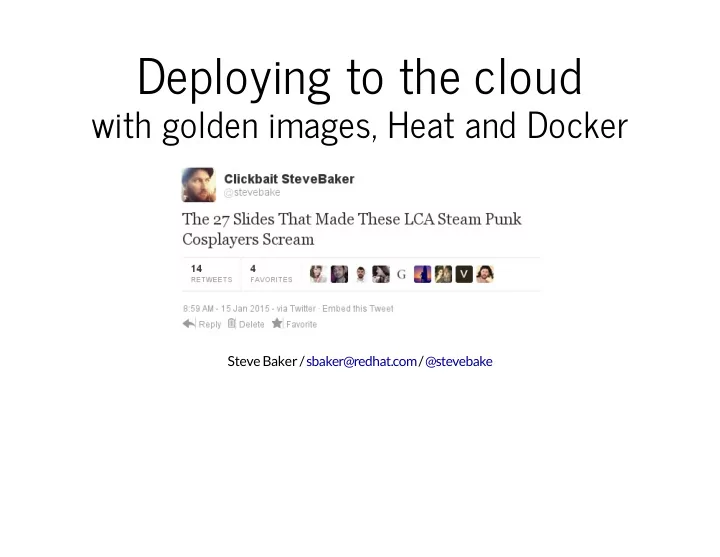

Deploying to the cloud with golden images, Heat and Docker Steve Baker / sbaker@redhat.com @stevebake /
Declarative vs Procedural Orchestration Procedural/Imperative describes a list of instructions to execute Declarative describes the desired state
What is Heat? Heat is a REST service for the declarative orchestration of multi- tenant OpenStack cloud services.
What is Heat Kubernetes? Heat Kubernetes is a REST service for the declarative orchestration of multi-tenant OpenStack cloud services containers.
I want to orchestrate containers in an OpenStack cloud No OpenStack container API :( Kubernetes / Docker are not multi-tenant APIs ;(
Evolution of Heat software configuration boot-time config - user-data script + cfn-init metadata, cloud-init / cloud-config config/deployment resources - shell / puppet / ansible etc
Kubelet Processes a container manifest so the containers are launched according to how they are described.
What is a pod?
What you don't get with kubelet vs full kubernetes no service load balancing no scheduler - requires manual placement of pods
Declarative Heat template heat_template_version: 2014-10-16 parameters: key_name: type: string resources: server: type: OS::Nova::Server properties: image: Fedora-x86_64-20-20140618-sda flavor: m1.small key_name: {get_param: key_name} outputs: server_ip: value: {get_attr: [server, first_address]}
Building a stand-alone heat appliance To run the latest heat against a cloud with no (or older) heat
Heat architecture heat-api rabbitmq heat-engine mysql
Heat HA architecture haproxy heat-api heat-api heat-api rabbitmq heat-engine heat-engine heat-engine mysql
Heat appliance pod heat-api rabbitmq heat-engine mysql
Building the docker image # heat-base-standalone/Dockerfile FROM fedora:20 MAINTAINER Steve Baker <steve@stevebaker.org> ADD heat /opt/heat ADD install-heat.sh /opt/install-heat.sh RUN /opt/install-heat.sh ADD config-heat.sh /opt/heat/config-heat.sh # heat-api-standalone/Dockerfile FROM stevebake/heat-base-standalone MAINTAINER Steve Baker <steve@stevebaker.org> ADD ./start.sh /start.sh CMD ["/start.sh"]
Building the VM image Built using diskimage-builder Uses the heat-config-kubelet element from the heat- templates repository https://github.com/openstack/heat- templates/tree/master/hot/software-config Currently Fedora only (lots of systemd) Includes a tar file of docker images for import on boot
Images and Security “...the code responsible for downloading images is shockingly insecure. Users should only download images whose provenance is without question. At present, this does not include “trusted” images hosted by Docker, Inc” - Jonathan Rudenberg https://titanous.com/posts/docker-insecurity
Images and Security “...one of the most important ways you can protect yourself when using Docker images is to make sure you only use content from a source you trust and to separate the download and unpack/install steps. The easiest way to do this is simply to not use “docker pull” command.” - Trevor Jay https://securityblog.redhat.com/2014/12/18/before-you- initiate-a-docker-pull/
Writing the heat template resources: heat_pod_config: type: OS::Heat::StructuredConfig properties: group: kubelet config: version: v1beta2 containers: - name: rabbitmq image: {get_input: rabbitmq_image} ports: - containerPort: 5672 hostPort: 5672 - name: mariadb image: {get_input: mariadb_image} ports: - containerPort: 3306 hostPort: 3306 env: - name: DB_ROOT_PASSWORD value: {get_input: mariadb_password} volumeMounts: - name: mariadb-data mountPath: /var/lib/mysql - name: heat-engine image: {get_input: heat_engine_image}
Launching the stack You launch the heat-standalone template Heat launches VM with kubelet-enabled image Heat builds data describing pods to create VM agent fetches data, writes out pod template files Kubelet picks up files, creates containers VM agent monitors for container creation, signals Heat with results
Launching the stack 0:00
Lifecycle of container stacks Image releases handled with heat stack-update Container architecture changes handled with heat stack- update Other workflows handled procedurally (with zero or more stack-updates)
Evolution of Heat software configuration boot-time config - user-data script + cfn-init metadata, cloud-init / cloud-config config/deployment resources - shell / puppet / ansible etc config fed to service running on host - docker / kubelet (future) config driving heat-provisioned cluster - kubernetes / etcd / mesos
Next steps Expose cAdvisor stats as deployment outputs Bring up a full Kubernetes cluster with heat, define containers in heat template, use unmodified Atomic OS image Encourage Kubernetes to declare stable interfaces for its components
Other container things in OpenStack Nova Docker driver https://github.com/stackforge/nova-docker Heat contrib docker API resource plugin OpenStack Magnum multi-tenant container API https://github.com/stackforge/magnum Heat templates for Atomic based Kubernetes cluster https://github.com/larsks/heat-kubernetes
Get the code https://github.com/steveb/docker-heat-templates https://github.com/openstack/heat- templates/tree/master/hot/software-config
Questions? Steve Baker / sbaker@redhat.com @stevebake /
Recommend
More recommend